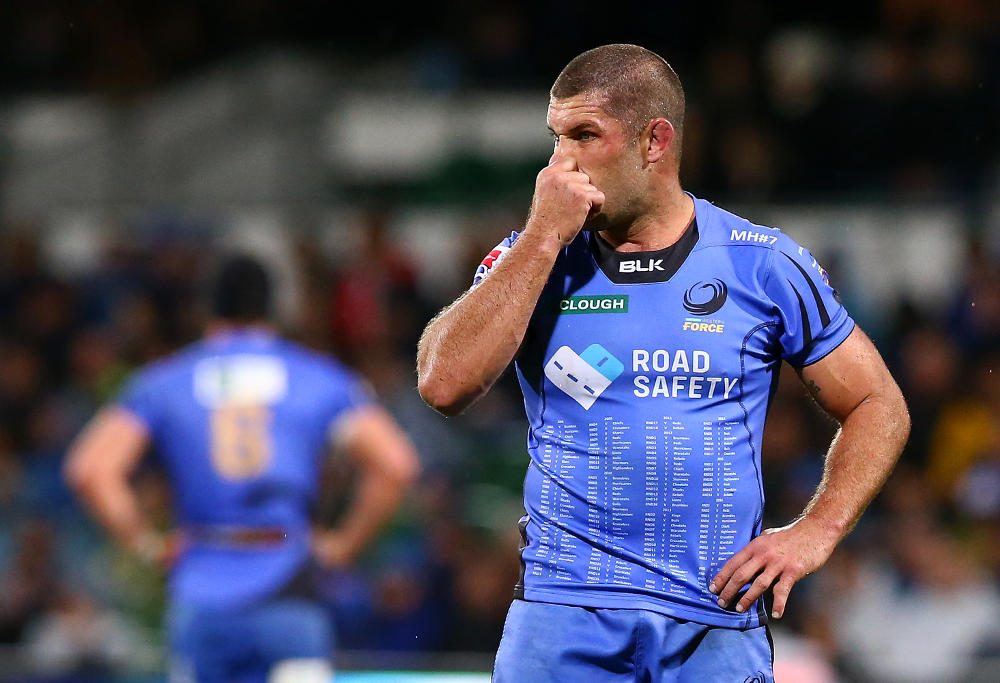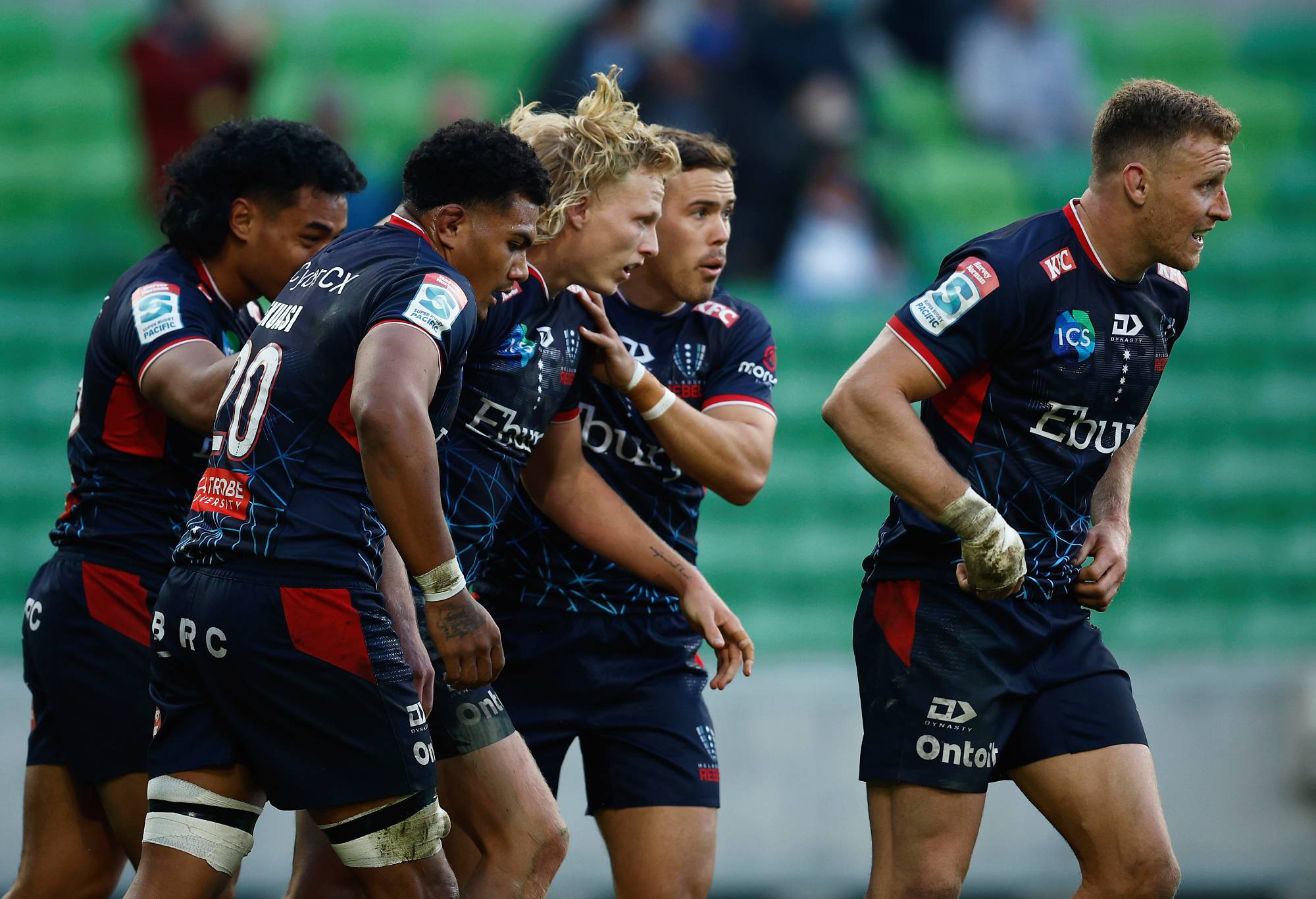COMMENT: It was an incredible moment in the history of modern Australian rugby.
The rain was closing in on the evening of 15th July 2017 in Perth, as over 10,000 fans crowded into HBF Park, at the time NIB Stadium. With the entire squad arm-in-arm, Twiggy Forrest told them that he would stand shoulder-to-shoulder with them and would support them no matter what.
Matt Hodgson, the bloke who has played more games for the Force than any other was retiring, and all that stood in their way was a star-studded Waratahs side featuring Sekope Kepu, Dean Mumm, Ned Hanigan, Michael Hooper, Bernard Foley, Rob Horne, Andrew Kellaway and Israel Folau in their ranks.
Worry not. As the rain came down, the Force played like their club’s survival depended on it. The match contained moments now etched into the club’s folklore, from a try in the first minute to Alex Newsome to the incredible final play that saw Matt Hodgson take the penalty shot on goal, with his dad Max being lifted to his feet to watch.

Matt Hodgson led the Western Force during their tumultuous 2017 campaign. (Photo by Paul Kane/Getty Images)
Final score, 40-11. A complete demolition, and to this day, the Force’s largest win in Super Rugby.
It would prove to be a moment that would keep many of the Perth faithful holding onto hope, as it signalled the start of three uneasy years in the wilderness. But the community support it helped to galvanise was nothing short of incredible. Return, the Force eventually did, and their future in 2024 looks increasingly brighter.
It is an incredible story of community support for a club. But the contrast is notable when we compare it with the other team that was up for the chop in 2017, seven years later. Now is a different time for the Melbourne Rebels.
Of course, it isn’t a perfect comparison. Club supporters like Twiggy Forrest don’t come along often, and the Force wasn’t in the financial hole the Rebels reportedly are. But the response, both inside and outside Victoria, certainly has been more stark.
To be clear, it makes complete sense to have a Victorian Super Rugby team. Keyboard warriors will comment all they want, but Melbourne is the largest city by population in Oceania, nearly on par with the entire population of New Zealand.
It may also, arguably, be the most competitive single sporting marketing in Australia, but given that Victorian rugby have player numbers nearly double the size of Canberra and on par with Western Australia, there is an audience to market to.
It is in Australian rugby’s collective interests for the Rebels to succeed. They should be a regular finals contender, playing exciting rugby that has been teased so many times and is reflective of the exciting brand they portray.
Yet, as news of the Rebels’ financial situation was released to the public, the behaviour of the Rebels themselves has been notably different. Following a single club statement released in December (that the Rebels didn’t even allow fans to comment on), the club has been notably silent until a club meeting yesterday* in terms of giving updates about the status of the club.
Going into administration? Nothing. The club’s now-former chairman, Paul Docherty, standing down? Nothing.
Seven years is an eternity in Australian rugby, and in 2024 more than anything, we need honesty, accountability, and a clear direction from those leading our game.
Seeing the Rebels downplay a reported $10 million in debt (now reported as high as $20 million), a question has emerged, an uncomfortable, awkward question filled with dread to ask: What is the Rebels endgame here? Or more to the point – is their main priority to be a successful side, or to grow the game in Victoria?
The Rebels would probably answer (as they should) that it is both; the ideal long game is to have a successful Rebels team, regularly making finals and challenging for a title, filled to the brim with Victorian players who have come through the ranks of the Dewar Shield and the academy system.
Have the Rebels achieved that in 13 years of existence? Certainly, players have come through the ranks. But examining what the Rebels do with their players after Super Rugby is over is interesting.
Many of the Rebels players don’t play in the Dewar Shield. Looking at the current Super Rugby squad over the last two years, while ten players have played for the Wallabies, Australia A, the Sevens program or taken up an offer to play for the Barbarians, three have been affiliated with the University of Queensland, two with Bond University, three with GPS, one with Easts, one with Sunnybank, one with an NPC team (two more also played last season) and ten are affiliated with Wests Bulldogs, with the remainder either being new signings or recovering from injury in the off-season. Only one player in the senior squad, Divad Palu, still appears to play his rugby exclusively in Victoria.

Carter Gordon’s future in Melbourne is uncertain. Photo: Daniel Pockett/Getty Images
To be clear, this isn’t unusual, nor isolated to the Rebels: professional players need a high level of competition to keep fitness and physicality up, and the Dewar Shield isn’t a competition with as high a level of intensity as the Hospital Cup.
Teams like the Western Force and the Brumbies also have players who play in the Shute Shield and Hospital Cup. The big difference though is the Force and Brumbies also send players to their respective local competitions after Super Rugby concludes – not just academy players or extended squad members, but senior members of the squad.
In the latter half of the John I Dent Cup season, you will see players like Darcy Swain, Jahrome Brown, Tom Wright, Lachlan Lonergan and more play for their respective Canberra clubs. Ollie Cummins, Reesjan Pasitoa and Ian Prior will play over in the Fortescue Premier Grade, although fewer senior players took part last year due to their series with the Cheetahs.
The hope is that over time, clubs can learn from those professional players, and become a stronger, more reliable program, with the long-term goal of relying less on external competitions and building more local talent. It’s a long game process, and it is a far from perfect system as players being pulled in and out can ruffle feathers.
Building up a Dewar Shield or Fortescue Premier Grade-style competition doesn’t take years, but decades. RugbyWA has meddled around their competition format many times, trying to break up seasons and avoid one-sided blowouts, all to get that sweet spot of competitive rugby played at an intensity that benefits local players. The desire is there though, the aim to grow locally is clear.
The Rebels do pull locally with their other representative teams, with over two-thirds of the U19s squad and all of their U16s squad coming from Melbourne pathways. The vast majority of their Super W side also plays in the Lindroth Cup, with a few also straddling several competitions.
However, the senior men’s side sees nearly all players go elsewhere to play their off-season rugby, even the likes of locally grown talent like Isaac Aedo Kailea, Josh Canham, Daniel Maiava and the Vaihu brothers, who all play in Queensland.
Again, the reasoning to make a competitive side makes sense if you are the Rebels, and is much faster than decades of investment in a local competition. On the flip side, how does such an approach benefit the likes of Dewar Shield clubs? What message does it send if you wish to aspire to play for the Rebels? Go to Sydney or Brisbane?
Does this current approach encourage community engagement and grow the quality of the game in Victoria? Or, does it turn the Dewar Shield into a feeder system for clubs in Queensland, with the Rebels hoping they can reap the benefits down the track?
It certainly proves beneficial for the likes of Queensland clubs involved like Wests, who won the 2022 Hospital Cup and were runners-up in 2023.

Rebels captain Brad Wilkin during last year’s Super Rugby season. (Photo by Mark Kolbe/Getty Images)
Simon Cron admitted that in his first year as coach at the Force he has aimed to understand the Perth rugby community, and maybe it is the case that years out of Super Rugby Pacific have galvanised a desire to understand what WA rugby looks like, and by extension, reinforce the WA franchise in the community.
What does the Melbourne rugby community look like? How do the Rebels wish to engage that community?
Again, it brings us back to the question of what is the Rebels endgame, and the answer is clearer more than anything else, winning is the priority. By winning more, they can galvanise local fans and support.
The problem is, does winning guarantee that? The Brumbies certainly have been winning a lot more, and reports today are they are also in financial trouble.
To grasp that winning culture, over the last 13 years, the Rebels have amassed a revolving door of incredible talent coming through their ranks, for a lone finals berth. So many times we have found ourselves saying that with the talent available, this is Melbourne’s year. Until now, it has come to naught.

New Rebels recruits Filipo Daugunu and Matt Proctor react during their trial against the NSW Waratahs at Harold Caterson Reserve on February 03, 2024 in Melbourne. (Photo by Morgan Hancock/Getty Images)
The Rebels team have done a stellar job assembling a quality squad for 2024: this is a side that, on paper, should make finals. But then again, we’ve been here before. If there is any year the Rebels need to succeed and bring fans on board, this has to be it.
There are encouraging signs with a strong trial performance against the Waratahs and an estimated 3,000 fans who turned up at Moorabbin, and we should be hopeful the Victorian rugby public will see the challenges the club faces as a chance to get behind their side. But their approach of a winning team falls flat if they don’t win once the season gets underway.
If the financial situation is as tenuous as they say, the Rebels could be playing for more than just the Super Rugby Pacific title in 2024. Will they produce a performance similar to that thundering night in Perth?
If it’s not now, it could be never.
*Details around the Rebels club meeting can be found in the comments below.
































































































